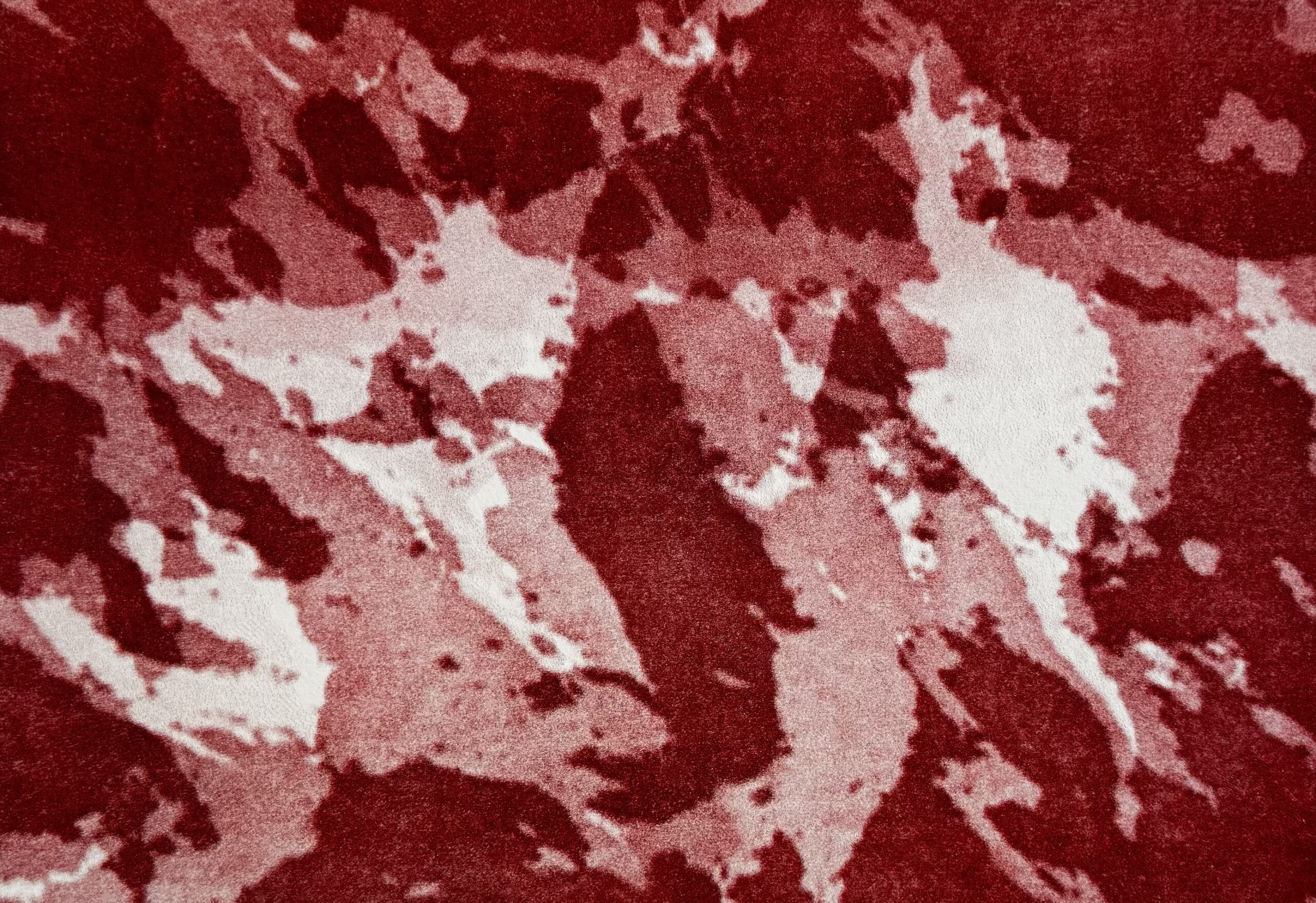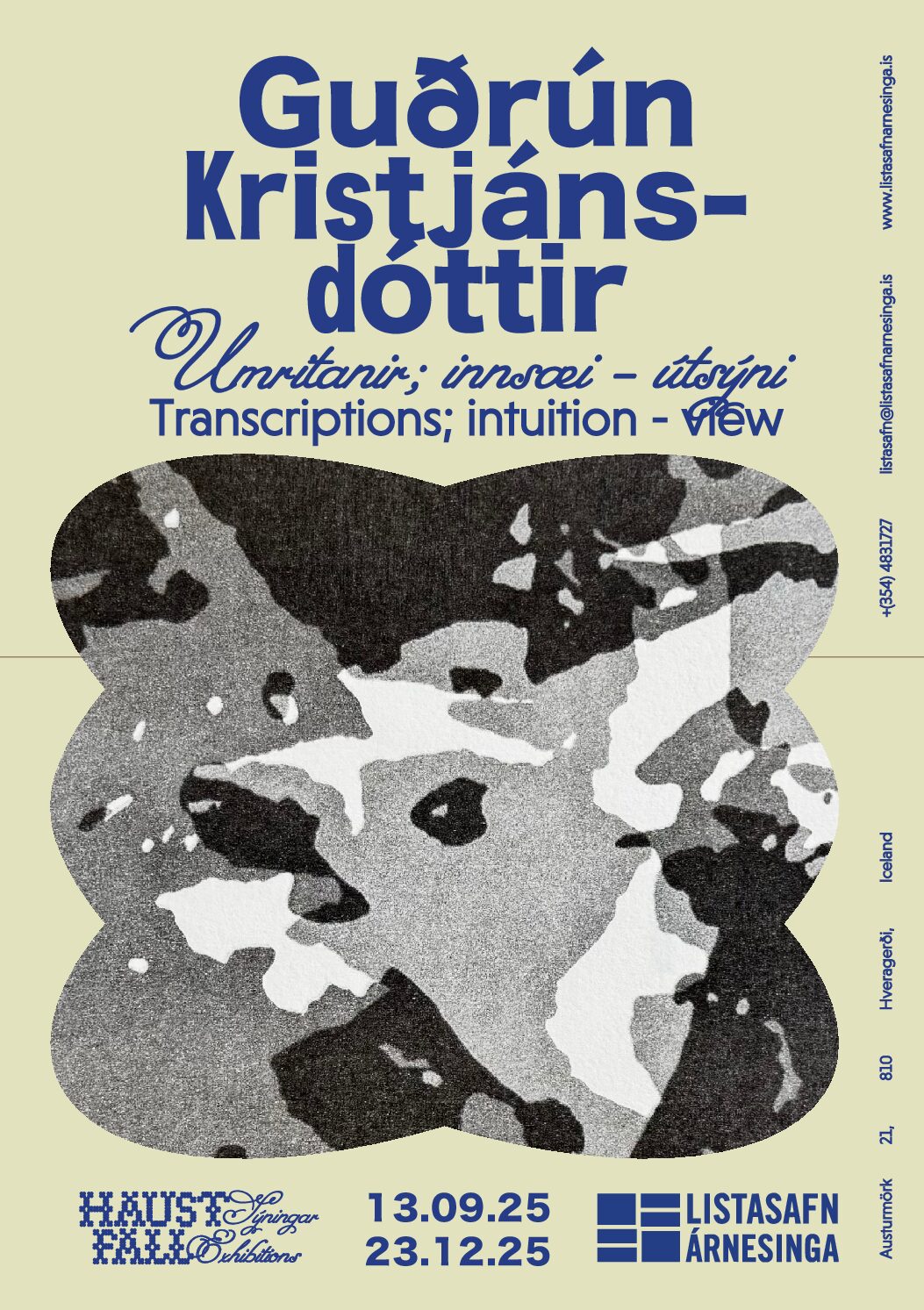
Transcriptions; Intuition-View
Guðrún Kristjánsdóttir
Curators: Oddný Eir Ævarsdóttir & Sigrún Kristjánsdóttir
Gallery 3
13th September – 23rd December 2025
Guðrún Kristjánsdóttir’s exhibition Transcriptions; Intuition – View at the LÁ Art Museum in Hveragerði is an installation which seeks to approach the sensory field behind the artist’s oeuvre. The installation comprises new works in dialogue with older ones.
Essential feeling, moon
Time passes more slowly here, and one attains more closeness with nature… and in fact with everything… here the tidal range is four or even five metres, twice a day! Those are prodigious powers, that surely have a bigger impact that one imagines. I am, really, seeing the moon in an entirely new light here.
Is it possible that there may be some deeply-rooted essential feeling in us that colours our entire life’s work, even though one may believe that one faces a series of different challenges? What are the emotional, or sensory, riddles one is constantly grappling with?
Lignite, sun
Here, in a new place, the lignite came to me along with all its time: carbonised plant matter through compressed geological strata. It is entrancing to handle a substance that is millions of years old, and feel how one bonds with it. I use it for drawing, and I am also experimenting with grinding up the lignite and rocks I find around here and using them as pigments in paint – making my works of art with that old time, the legacy of a natural process of decay and renewal.
The sun has never been a subject of mine, but after I started observing how it touches the lines by the sea here, it has established itself in the picture.
I have always found the time just before twilight very interesting – the moment when the day is fading away.
Rotations, lines
In her work, the seasons often merge together. As do the media. It is as if she is setting out to confuse us – to induce us to ask her questions – to pay attention to what we have taken for granted, or not noticed at all. Mum taught us to notice the rotations in nature. To notice the changes, fast or slow. To read the land, to learn it. To notice the difference – that sometimes-trivial difference which is nonetheless crucial. Follow the movement. See the boundary, see the line. Allow the land, slowly but surely, to become the starting-point of thinking and emotions – to permit it to become a zone within us.
Ciphers, harmony
The medieval nun Hildegaard von Bingen, with whom my mother engaged in a dialogue in the work Sam¬hljómur (Harmony), experienced auditory visions in her exploration of the godhead; those visions were so difficult to transcribe that she had to invent her own language, Lingua ignota (mystic language). Mum doesn’t believe in her visions as in God, but she has built up a good collection of code-letters or ciphers in her snow archives. Gradually an alphabet emerges: series of perceptions, symbols, images, snows, weathers. For us it is like Braille lettering – a random selection of marks left by weather, meaningless hieroglyphs. But maybe, one day, we will discover the key to the code… Proportions that encompass the truth. So dynamic that they put self-delusion to flight.
Golden Section, continuity
The Golden Section is an attitude: a desire for ongoing connection. The experiments were not about perfection, but continuity. I saw the artist’s work in a different light: it was not only intimidating. It gave life, and family life, a purpose. I saw that Mum was not tormented by obsession in her studio, though she was alarmingly focussed. She whirled around like a Sufi dervish in the desert. She connected the forms together, and they rotated in time with the whims of nature and seasons. They freed themselves and were transcribed again.
Sensory fields, snow layers
Observing snow layers, changeable weather, the moon, stars, sun. Taking in their influence, letting them simmer in the subconscious… gathering materials before setting to work. I feel powerless, yet I long to capture in my works the feeling for something which is magnificent and at the same time delicate. And that equivalence with one’s inner self – how one senses the land, how the land changes according to fluctuations in the weather, just as one does oneself.
What sensory field is one trying to draw up? How can one work through that tangle of external circumstances and inner life? And how does the human sensory field form, or evolve, in that complex context, how does it become clearer and simpler?
It is necessary to recall the original delight, if something occurs in a close relationship – and try to make contact with it. Instead of focussing on the fault, to revivify the essential desire.
Liminality, playfulness
For me, entering Mum’s studio was like passing into another dimension. Her absolute focus and passion were infectious, as well as her playfulness and inventiveness. In physics and anthropology, the concept of liminality is used to convey the certain point in the process of change when things have not happened yet, where everything is imperfect, and possible. In such a transitional phase, uncertainty tends to prevail. Psychoanalysts Carl Jung and Julia Kristeva have maintained, each in their own way, that it is as unhealthy never to experience such uncertainty, as to spend too much time in that situation. I think that it is a shared attribute of artists that they develop a tolerance for uncertainty in order to maximize the duration of the liminal state.
Transcriptions, the outlandish
When I opened a drawer of her sketches, and saw on her computer all the files of transcriptions, I thought of the medieval scribes whose job was to copy manuscripts – for a piece of writing often existed in many variant copies. And my mind wandered to weather journals in the dry style of reports, which gradually evolved into personal diaries. And I thought of translators, who strive to transpose the meanings of the mother tongue into other languages. The translation gives rise to a new meaning, which lies hidden between the lines. It adds a new layer to the text – invisible, transparent. Transcriptions take place in many fields; perhaps musical transcriptions are those that have most in common with Mum’s snow-shape experiments – when a work is transcribed for a different instrument, of for another kind of performance. Mum is not only transcribing the manifestations of nature and its fluctuations. She gradually makes them her own symbols, by transcribing from one medium to another: from photograph to painting; from painting to drawing; from video to painting; from drawing to installation; and so on. Composer Béla Bartók, for example, travelled around the rural areas of his country, Hungary, writing down compositions and musical phrases that had survived only orally, as hummed and crooned by mothers. He transcribed the music, and then transcribed it again. Transcriptions, like translations, demand resourcefulness and imagination, even though – or precisely when – the scribe/transcriber/translator aims to capture the original work in its truest form. And in visual art, the artist moves from one medium to another, round and round again; the transcription is far away from the original: it has long ago achieved the outlandish in its quest for truth.
Intuition – view
On a journey through the central highlands – I don’t remember what rocky upland road it was – Mum asked to get out of the car so she could look at a mountainside through the mist long enough to see something. We kids protested: we thought we could see the mountains quite well enough through the car windows. “Yes, that’s good too,” she said, but she asked us to get out of the car with her and see the difference. We stood there gazing at remnants of snow in the black sands – different fragments as the mist drifted around. What story is it? In what language? “I don’t know,” she replied, telling us to read with our inner eye. It would take a while for the intuition to open up. It took us a few more years to find that inner eye – if we ever have. But we felt the opening up.
Transcriptions, intuition
With various methods and media, I transcribe forms from nature, or their impact upon me. Or an I transcribing the view that intuition opens up, or the intuition with the view?
The texts are drawn mostly from Bláleiðir (Mother’s Marginalia; The Mountain Manuscript), a work of book art grounded in Guðrún’s artistic career, and on discourse between mother and daughter which has sparked a re-examination of her oeuvre. In collaboration with her daughter, Oddný Eir, editor of the work of book art, and Kristín Scheving, director of the LÁ Art Museum, Guðrún continues here to explore how a fundamental artistic sense connects the works via transcriptions in diverse media, through a tangle of circumstances, in interplay of intuition and view.
.


